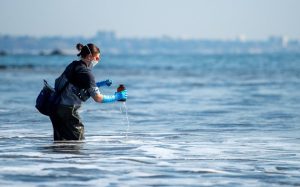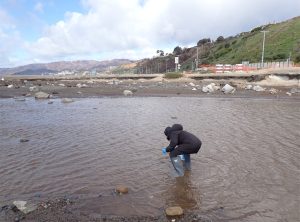SCCWRP coordinates post-fire aquatic monitoring network

SCCWRP has helped bring together more than two dozen organizations to form a water-quality monitoring network that is tracking how pollution and debris from the Palisades and Eaton fires are spreading through coastal ecosystems and adversely affecting ecological and human health.
The Los Angeles-area Post-Fire Water Quality Monitoring Network – which was formed in February following two of the most destructive fires in Los Angeles County history – is working to generate high-quality, comparable data on the levels and types of common post-fire contaminants in aquatic systems, as well as general chemistry measurements such as dissolved oxygen and suspended particles.
The Los Angeles Regional Water Quality Control Board, which is overseeing California’s post-fire monitoring in aquatic habitats, and the California Ocean Protection Council asked SCCWRP in January to lead the development and facilitation of the Post-Fire Water Quality Monitoring Network. SCCWRP rapidly organized a 25-agency workgroup that is monitoring nearly 200 sampling sites across Santa Monca Bay and the Los Angeles River and San Gabriel River watersheds.
In April, SCCWRP worked with the Los Angeles County Department of Public Health to unveil an initial version of a post-fire water-quality monitoring data portal that serves as a centralized place to publish results from all the sites monitored and constituents measured.
The monitoring data will help inform a range of post-fire management decisions, including determining if and for how long to close beaches due to post-fire runoff contamination, whether to issue fish consumption advisories for contaminated fish and shellfish, and how to remediate post-fire pollution in sediment and sand.
Following the Palisades and Eaton fires and subsequent storms in January, dozens of organizations jumped into action, rapidly mobilizing to begin tracking what levels and types of pollutants and debris from the fires were entering aquatic systems, where and how far these pollutants are traveling, and how aquatic life and humans were being affected.
Fire-related contaminants being measured include heavy metals (e.g., mercury, lead) and combustion byproducts that are known carcinogens (e.g., polycyclic aromatic hydrocarbons). Other general water chemistry parameters often affected by wildfires also are being measured, including dissolved oxygen, pH and amounts of suspended particles.
The speed of the post-fire monitoring response led to multiple challenges, including gaps in monitoring locations, overlap and duplication of efforts, and inadequate training in the use of rigorous sampling and analysis methods. Monitoring groups also lacked a structured mechanism through which to share their data, and to adjust their monitoring designs over time.
SCCWRP, which already had been informally receiving requests for guidance and support from individual monitoring participants, was well-positioned to rapidly organize and coordinate among disparate groups, given the agency’s reputation as a neutral scientific authority that diverse groups trust to develop and lead cross-sector monitoring programs.

Already, the network has helped forge new partnerships that have led to coordinated sampling efforts and sharing of samples and sampling resources. Through the network, monitoring participants also have expanded the number of monitoring sites and the number of constituents of potential concern to human and aquatic health. Meanwhile, monitoring groups with limited experience doing post-fire monitoring are learning how to collect, preserve, and analyze samples, and interpret their results with the appropriate context.
The L.A.-area post-fire water-quality monitoring network is part of a larger, coordinated statewide effort to comprehensively track the environmental consequences of the Palisades and Eaton fires.
While the water-quality monitoring network is focused on the coastal ocean and watersheds, a separate group is tracking contamination of swimming pools by post-fire airborne pollutants. Other groups are monitoring indoor air quality, outdoor air quality, soil quality (including beach sand and dust), debris, and human health (including fire-related pollutants found in bloodstreams).
To ensure all monitoring data are publicly accessible, the Los Angeles County Department of Public Health has developed a data dashboard that presents all published air, water and soil data on an interactive mapping tool.
As more water quality data are collected, SCCWRP and its partners are planning to conduct a large-scale synthesis of overall post-fire water-quality effects to the Los Angeles region, as well as compare the findings to available risk thresholds for aquatic and human health.
For more information, contact Dr. Alvina Mehinto.
More news related to: Emerging Contaminants, Regional Monitoring, Top News